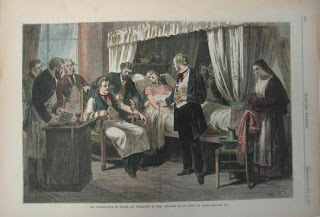The Beginnings of Transfusions

This week I am off to the National Hemophilia Foundation meeting in San Francisco, and I thought an historical look at blood might be in order. I can’t think of a better story about blood than one that starts with a madman running naked through the streets of Paris in the 17th century. True.
Chapter 1 of the wonderful book Blood by Douglas Starr starts with poor Antoine Mauroy, who suffered “phrensies.” From time to time, he would take off his clothes, run through streets and set fires. Eventually, doctors experimented on him to try to cure him. Mauroy became the guinea pig in an experiment that forever changed medicine. In 1667 Jean-Baptitste Denis, physician to king Louis XIV, transfused half a cup of blood from a calf into Mauroy. He hoped the “gentleness” of the calf would infuse as well. Despite the discoveries of the Renaissance and the advances made in science, doctors still believed the blood somehow carried the characteristics of the creature, a concept known as “vitalism.” For example, a stag’s blood carried courage; a calf gentleness. Since the ancient Greeks, the body was not yet viewed as a system, and doctors knew nothing of hormones, genes or viruses. It would be 200 more years before they discovered that water transported disease! In the 17th century, doctors believed that in the “humors”: phlegm, choler, bile, blood. The Greeks believed that good health meant maintaining a balance of the humors in the body, so draining blood and purging digestive system should help. This is where blood-letting as a medical treatment evolved.
Blood– it has a colorful past! And worth reading about. Be sure to read Blood by Douglas Starr.
Other doctors and researchers dabbled in finding out the secrets of the blood. William Harvey found valves in blood vessels, which led him to think that the body might be a system, more mechanical. Christopher Wren (the famous architect whose beautiful cathedrals I just glimpsed when I was in London last week) and Robert Boyle, founder of modern chemistry, dabbled in circulation. Richard Lower tried transfusing blood from one dog to another: he discovered how to transfuse from an artery into a vein and it worked.
What happened to our madman? Antoine Maury died from the procedure. What doctors didn’t know is that proteins in the blood from one animal–even from another person– are not always accepted by the body. The immune system may attack the foreign proteins. Dr. Denis was accused of murder. He in turn sued Antoine Mauroy’s widow in 1668 for slandering his reputation. Turns out Mauroy actually died from arsenic poisoning– by his wife! Still, the French Parliament’s banned all transfusions involving humans. Similar actions follow in England and Rome. And 150 years would pass before it was tried again.

